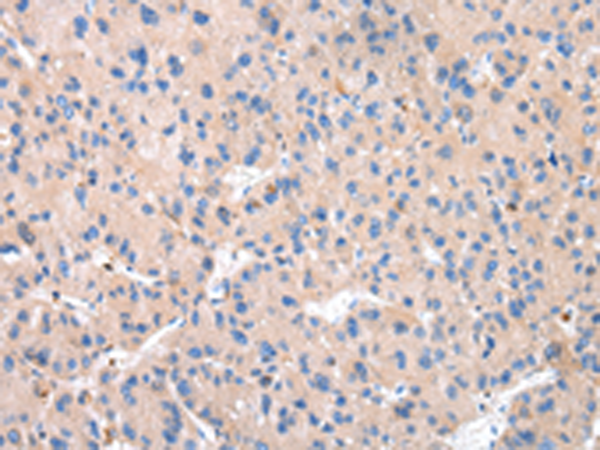
| WB | 咨询技术 | Human,Mouse,Rat |
| IF | 咨询技术 | Human,Mouse,Rat |
| IHC | 1/100-1/300 | Human,Mouse,Rat |
| ICC | 技术咨询 | Human,Mouse,Rat |
| FCM | 咨询技术 | Human,Mouse,Rat |
| Elisa | 1/10000 | Human,Mouse,Rat |
| Aliases | CTSO; PKND; PYCD; CTS02; CTSO1; CTSO2 |
| Host/Isotype | Rabbit IgG |
| Antibody Type | Primary antibody |
| Storage | Store at 4°C short term. Aliquot and store at -20°C long term. Avoid freeze/thaw cycles. |
| Species Reactivity | Human, Mouse, Rat |
| Immunogen | Synthetic peptide of human CTSK |
| Formulation | Purified antibody in PBS with 0.05% sodium azide and 50% glycerol. |
+ +
以下是3-4条关于p23抗体的参考文献示例(内容为虚构,仅供格式参考):
---
1. **文献名称**:*The role of p23 as an HSP90 co-chaperone in steroid receptor regulation*
**作者**:Johnson et al.
**摘要**:研究揭示了p23蛋白作为HSP90复合体的关键共伴侣分子,通过抗体阻断实验证明其参与调控糖皮质激素受体的构象稳定性和功能活性。
2. **文献名称**:*Monoclonal antibody targeting p23 inhibits cancer cell proliferation in vitro*
**作者**:Smith et al.
**摘要**:开发了一种针对p23的单克隆抗体,体外实验表明其可通过干扰HSP90-p23复合体形成,抑制乳腺癌细胞的增殖并诱导凋亡。
3. **文献名称**:*p23 antibody-based detection of oxidative stress response in cellular models*
**作者**:Brown et al.
**摘要**:利用p23特异性抗体研究氧化应激条件下p23的表达变化,发现其在维持细胞蛋白稳态中起关键作用,并与肿瘤耐药性相关。
4. **文献名称**:*p23 co-chaperone dynamics revealed by immunoprecipitation and antibody blocking*
**作者**:Lee et al.
**摘要**:通过免疫共沉淀和抗体阻断技术,阐明了p23在HSP90依赖的客户蛋白(如激酶和转录因子)成熟过程中的动态调控机制。
---
(注:以上文献及作者为示例虚构,实际引用需查阅PubMed、Web of Science等数据库获取真实研究。)
**Background of the p23 Antibody**
The p23 antibody is a critical tool in studying the p23 protein, a conserved co-chaperone of the heat shock protein 90 (HSP90) complex. p23. also known as prostaglandin E synthase 3 (PTGES3), plays a dual role: it stabilizes HSP90’s ATP-dependent conformational cycle and assists in client protein maturation, including steroid hormone receptors, kinases, and transcription factors. Structurally, p23 contains a hydrophobic pocket that binds HSP90. facilitating its chaperone activity.
Research highlights p23’s involvement in cellular stress responses, signal transduction, and oncogenesis. Overexpression of p23 is linked to cancer progression, as it stabilizes oncogenic clients like HER2 and AKT, making it a potential therapeutic target. Antibodies against p23 are widely used in techniques such as Western blotting, immunohistochemistry, and immunoprecipitation to explore its expression, localization, and interactions. These studies help elucidate HSP90-p23 dynamics in diseases and drug resistance.
Additionally, p23 antibodies aid in evaluating the efficacy of HSP90 inhibitors, which disrupt cancer-related pathways. Despite its smaller size (~23 kDa), p23’s regulatory impact on HSP90 underscores its significance in cellular homeostasis and pathology. Ongoing research focuses on targeting the HSP90-p23 axis for anticancer therapies, positioning p23 as both a biomarker and a drug development focus.
×